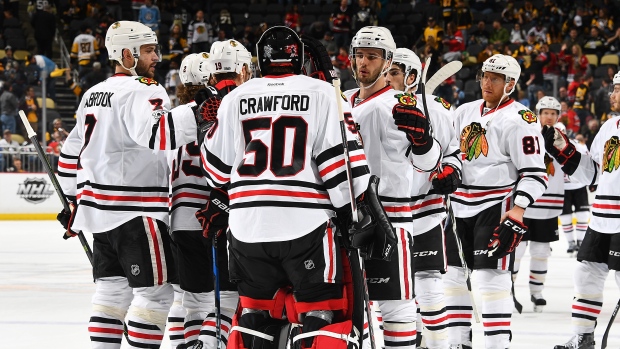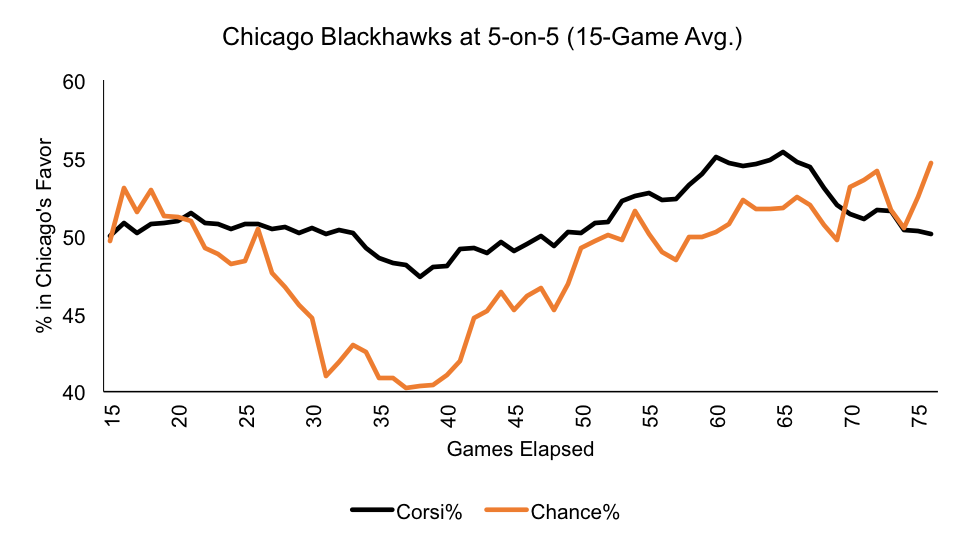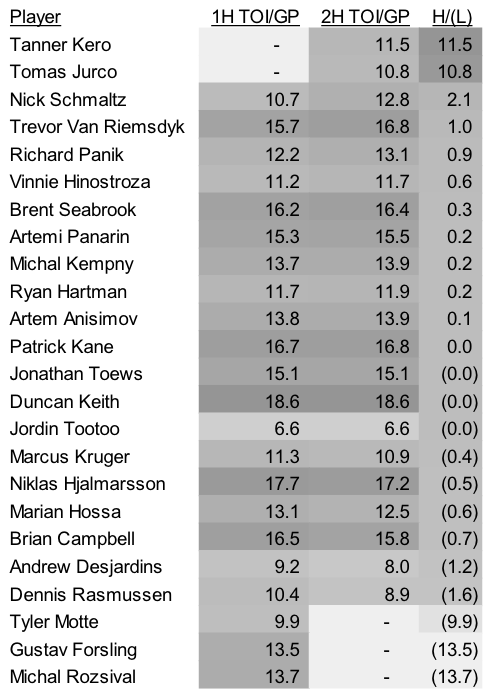Mar 30, 2017
The Blackhawks are all the way back
Joel Quenneville’s decision to shuffle the deployment of his depth players has Chicago looking dominant again, Travis Yost writes.
By Travis Yost

Last March, I wrote an article about the Chicago Blackhawks being extremely vulnerable to a first-round playoff exit.
The Blackhawks were a fine team last year, but nothing like the perennial powerhouse we had grown accustomed to in previous seasons. The 2015-16 team barely outshot their competition at 5-on-5 (they owned 50.3 per cent of the shots) and were actually outscored over the 82-game season (134 goals for, 140 goals against).
To put some context to those numbers, the Blackhawks of 2009-15 owned about 54.2 per cent of the shots and 54.2 per cent of the goals. As you might have guessed, their league-wide ranks in both categories were top three. Their 5-on-5 dominance was one of the big reasons the Blackhawks were more or less an annual lock to make the playoffs and push for a Stanley Cup.
There were plenty of theories around last year’s degradation, and that discussion only heightened after they were bounced in round one by the division rival St. Louis Blues. Had age caught up to the roster? Had the big contracts given out to star players hindered the team’s ability to maintain competent depth? Was the division simply improving?
All fair questions, which is why I was curious to see how the Blackhawks would respond this season.
And boy, have they responded.
The Blackhawks have turned it on down the stretch, including a 7-1-2 run in their last 10 games. In light of Minnesota and San Jose fading near the finish line, you have to wonder if they have established themselves as the favourite to come out of the Western Conference.
If you look at the Chicago season in 15-game segments, you can see that the early part of the regular season looked an awful lot like the end of last season. All of our key performance metrics suggested this was a team still missing something. And then, something clicked (data via Corsica):

It was right around the halfway mark of the season where Chicago started stepping on the gas. While there’s plenty of talent on this roster and it was absolutely reasonable to assume things would improve, I want to be clear about something: This Blackhawks team, for about 80-90 games spanning the end of last season and the beginning of this one, was shockingly average.
If you subscribed to the idea that age, contracts or some other variable had started eating away at the Blackhawks, how do you explain the improvement? The team’s now posting the exact 5-on-5 numbers we tend to see from talented playoff teams, owning the scoring chances and shot-differential battle on a regular basis.
One of the things I was curious about from this was to whether or not head coach Joel Quenneville had modified his deployment in any way. If you bucket Chicago’s season into two halves, you can see that it’s the depth that’s substantially changed in Chicago (minimum 10 games played).

The big additions during the second-half of the year were in Tanner Kero and Tomas Jurco. Nick Schmaltz also saw a pretty considerable jump in ice time. On the other end of the spectrum, the team dropped the likes of Tyler Motte, Gustav Forsling and Michal Rozsival, while also cutting the ice time of Andrew Desjardins and Dennis Rasmussen.
Did the change in the depth talent jump-start the Blackhawks? In some ways, I think so. My theory is that the newer blood is helping drive some favourable shot (and thus goal) numbers, and that the players phased down or out in the first half of the year were pretty big drags.
If you look at RelativeCorsi% (how much better are the Blackhawks from a shot differential perspective with a player on the ice vs. with him off of the ice), the shift is remarkable:

Jurco and Schmaltz are both positives on Chicago’s 5-on-5 play, which is remarkable considering that they are pretty new names to the Chicago organization. And while Kero’s a slight negative, it’s important to also note that he’s playing some brutally tough minutes – as just one piece of evidence of this, he’s starting about 40 per cent of his 5-on-5 shifts in the defensive zone.
The other piece of this is even more fascinating. The three guys who have all been taken out of the lineup in Motte, Forsling, and Rozsival were pretty considerable net negatives on Chicago’s even-strength play. The two guys who have had their minutes considerably adjusted – Desjardins and Rasmussen – have both seemed to have benefit from the shift.
Now, maybe some of this is Quenneville getting lucky. But even if just a piece of what he’s done with the lineup is real, then you have to give him credit for identifying a flaw on the team and acting accordingly. It seems to me that the lineup shifts – along with already having the high-end talent in place – have paid big dividends for this organization, enough to turn them back into a legitimate Stanley Cup threat.
Which raises the question: Is Joel Quenneville in the Jack Adams race? I think an argument can be made.

